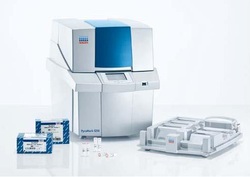 When talking or reading about pyrosequencing you're probably thinking immediately of the high-throughput 454 sequencing. This sequencing technique is based on the "sequencing by synthesis" principle and differs radically from the standard Sanger sequencing. It can be viewed as the qPCR version of standard PCR. This technique was commercialized by Pyrosequencing AB and has been further developed for high throughput sequencing by 454 Life Sciences. Qiagen acquired the pyrosequencing business line in 2008 and started developing the pyrosequence technique for low/medium throughput applications. So, even though it is based on the same technology (see video below), the pyrosequencing I am talking about here is NOT the 454 system but the Qiagen system! In the video above the pyrosequencing reaction is shown in an animated way with the graph output as you would get with Qiagen pyrosequencing software. I have used pyrosquencing to determine the ratio of two Single Nucleotide Polymorphisms (SNPs) at a certain genomic position. In my case I was dealing with a ratio of C/T SNPs in a 100 bp genomic region after bisulfite conversion of my genomic DNA. The technique is quite simple but also prone to errors if you don't take into account a number of optimisation steps. In this post I assume that you know the Qiagen pyrosequencing technique but you've run into some issues during the assay testing phase as I have.
Here, I give six ideas on how to optimize or troubleshoot your pyrosequencing assays!
0 Comments
Leave a Reply. |
Archives
September 2018
Categories
All
|
 RSS Feed
RSS Feed






